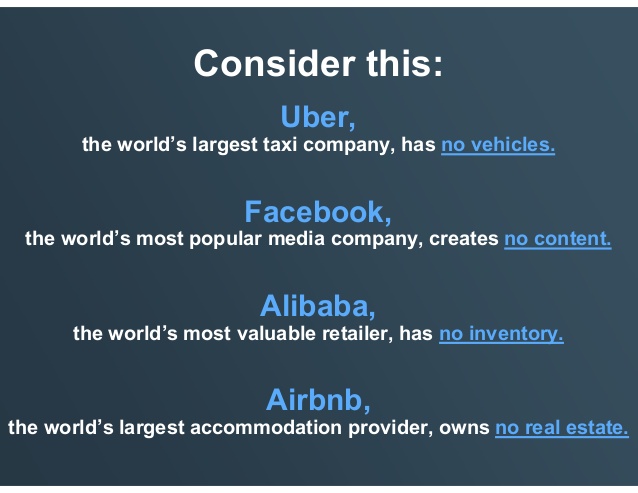Uber, the world’s largest taxi company, owns no vehicles. Facebook, the world’s most popular media owner, creates no content. Alibaba, the most valuable retailer, has no inventory. AirBnB, the world’s largest accommodation provider, owns no real estate.
What makes these players so incredibly successful and able to disrupt an entire market? There is one common thing among these companies; they all control the interface between the consumer and the provider of the goods or services. This brings these companies in an incredible valuable position. The companies don’t carry the costs of providing the good or service but they take a cut from the millions of consumers that buy from their platform. The interface and ability to connect is where the profit is.
It is the unique platform they offer to connect that creates tremendous valuations, for this reason these companies (Amazon, eBay, Uber, Airbnb, Zappos, etc.) are called network orchestrators. Within a short period of time these companies rapidly grew to very high valuations. But why is it that less than 5% of all companies are network orchestrators, despite the positive effect of the business model on several performance measures?
It is partly because business models are integrated into all parts of a company and therefore difficult to change. Changing the business model requires changing the capital allocation, but research shows that most companies follow the same allocation patterns every year.
Networks are sources of information and assets that lie in and around an organization. Unfortunately, most networks stay untapped. To become a network orchestrator, leaders must connect and activate the network of their organization. In this way they can create more value and better performance for their organization. To acquire this, the following steps are recommended to leaders:
1. Assess your business model. Understand which business models currently exist within your organization and also the preferences and biases of the leadership team members who have created these models through capital allocation.
2. Inventory your network assets. Take stock of your dormant network assets including customers, employees, partners, suppliers, distributors, and investors, and determine which have the greatest potential.
3. Reallocate your capital to networks. Divert at least 5% to 10% of investment capital to activating your networks. Take an experimental approach to early allocation and expect ongoing adaptation. This could be accomplished organically, or through acquisition or partnership.
4. Add network KPIs. Add to your standard financial metrics new network-oriented indicators such as number of participants, their sentiment, and level of engagement. These KPIs will provide direction for your network adaptation.
References
Libert, B., Wind, Y., and Beck, M. (2014, November 20). What Airbnb, Uber and Alibaba have in common. Retrieved from https://hbr.org/2014/11/what-airbnb-uber-and-alibaba-have-in-common
Stone, B. (2017, January 26). The $99 billion idea. Retrieved from https://www.bloomberg.com/features/2017-uber-airbnb-99-billion-idea
Stone, B. (2017, February 7). What made Uber and Airbnb so much more successful than existing companies in these spaces? Retrieved from https://www.quora.com/What-made-Uber-and-Airbnb-so-much-more-successful-than-existing-companies-in-these-spaces

